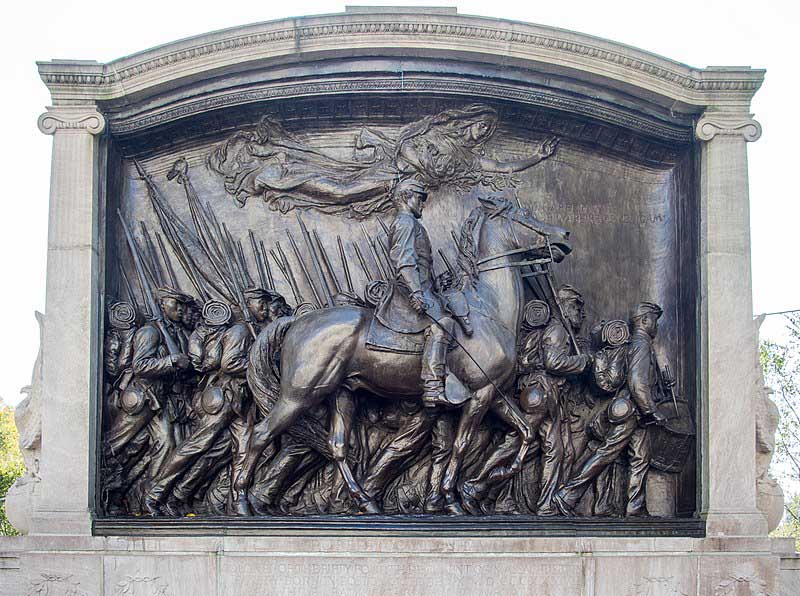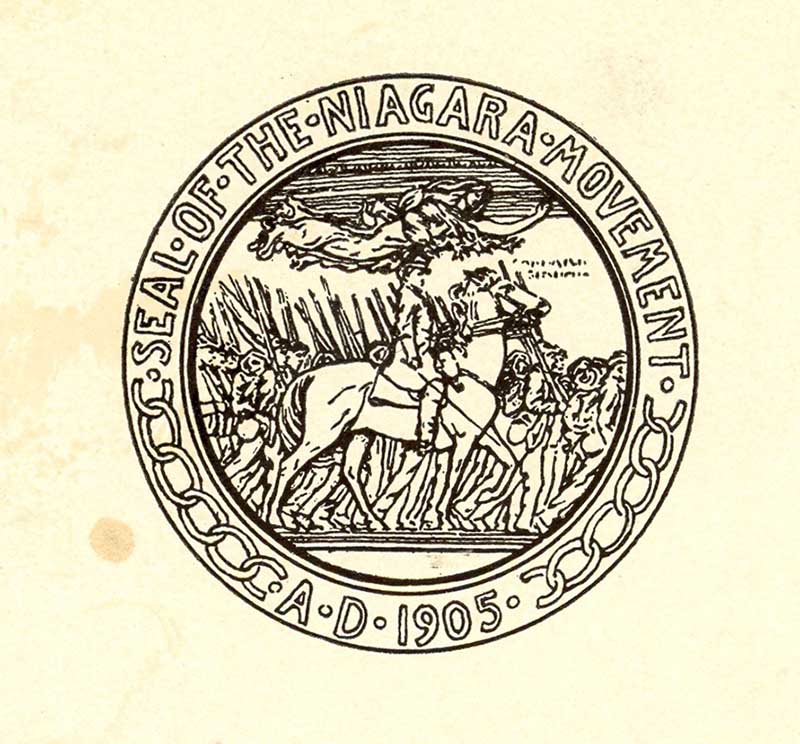The Shaw Memorial: A Reflection of Black Struggle
The Messenger series features scholarly articles exploring how Old North and our region fit into a greater historical perspective while celebrating the academic work of a variety of voices from students to casual history buffs to published authors and leading academicians.
The Shaw Memorial: A Reflection of Black Struggle
By William Stilwell

In 2016, Massachusetts unveiled a redesigned driver’s license, incorporating quintessential state images: the state bird, the chickadee; the state flower, the mayflower; and the beautiful golden dome of the State House. On the reverse, almost hidden, is an image of the memorial to the 54th Massachusetts Regiment and Col. Robert Gould Shaw. Out of all of these images, this is the one Bostonians should have the most pride. The relief, designed by artist Augustus Saint-Gaudens and dedicated on May 31, 1897, on the Common across from the State House, is the oldest monument built to honor any of the nearly 200,000 Black men who fought for the Union during the Civil War, collectively known as the United States Colored Troops (USCT).[1]Despite the fact that African-Americans eventually comprised ten percent of the Union forces, only a small fraction of the approximately 6,000 Civil War monuments and memorials honor these men.[2]For almost a century the memorial overlooking Beacon Street was one of only a scant few honoring these men who were instrumental in the destruction of slavery. I t has been a 150-year struggle to appropriately honor the 54th in a way that befits their contributions and in a way that a white regiment of similar accomplishment would have been honored.
The iron gate of our prison stands half-open. One gallant rush from the North will fling it wide open, while four millions of our brothers and sisters shall march out into liberty.[3]
This was Frederick Douglass’ recruitment pitch to the free Black men across the United States to enlist in the newly organized Massachusetts 54th Volunteer Regiment, the first regiment organized in the North for Black soldiers, in March of 1863. President Lincoln’s Emancipation Proclamation had not only freed those enslaved in the rebelling states; it also allowed for the enlistment of Black men into the Union Army. From the start of the war, Douglass had been an advocate for allowing Blacks to serve in the army, but it took well over a year of fighting for President Lincoln to overcome Northern racism and allow the recruitment of Black soldiers. Governor John Andrew of Massachusetts, an abolitionist, then organized the first Northern all-Black regiment. Douglass recruited soldiers, including two of his own sons, and other Black abolitionists from all across the United States and as far away as Canada and the Caribbean. The African Meeting House on Joy Street became a recruitment center for the new Regiment in Boston’s Black community. However, keeping in line with the prevailing and racist view among Northern whites that Black people were inferior, the officers leading these new regiments were required to be white. Gov. Andrew personally recruited Col. Robert Gould Shaw, the son of radical abolitionists and an experienced soldier, to lead the 54th.
On May 28, 1863, Shaw and his men shipped out from Boston’s North End to South Carolina,[4]but before even reaching the battlefield, the men had to fight the racism of the Federal Government. Despite being promised the same pay as their white counterparts, $13 a month, they instead were paid $10 with $3 withheld for clothing and supplies.[5]In protest, the men refused to accept payment, and the issue was not resolved for months, despite the best efforts of Governor Andrew.[6]On July 18th, 1863, the 54th led the charge on Fort Wagner in Charleston harbor. An extremely dangerous mission that was ultimately unsuccessful, Col. Shaw was killed almost immediately,[7]and nearly half of the Regiment were killed, wounded, or missing.[8]After the flag-bearer was shot down, formerly enslaved Sergeant William Carney of Norfolk, Virginia grabbed the colors and brought them back behind friendly lines, getting wounded in the process.[9] The 54th finally received their promised pay in July of 1864, and they continued to see action until the end of the war.[10]
The first attempt to commemorate the 54th and the assault on Fort Wagner occurred not long after the war, with veterans of the 54th and another Black regiment planning a monument for Beaufort, South Carolina near the site of the battle – which fell through – and officials in Boston began the process of constructing a monument in 1865. The project did not begin until 1883, when Irish-born artist Augustus Saint-Gaudens was hired to design the monument,[11]but it was another fourteen years before the monument was complete. Saint-Gaudens initially planned to sculpt an equestrian statue of Col. Shaw, but his parents insisted the men of the 54th should be included as well. Saint-Gaudens hired models off the streets of New York City to create the stoic faces of the men marching alongside Shaw. Despite the inclusion of the enlisted men, the monument still reflects a racist hierarchy. Shaw stands front and center, focusing on the white officer, and the names on the inscribed in stone on the reverse are only the white men of the regiment.[12]But at the dedication in May of 1897, Booker T. Washington gave the keynote address, and the veterans of the 54th returned to march up Beacon Street. Sergeant William Carney, soon to finally receive his Medal of Honor, once again carried the flag.[13]
Saint-Gaudens exhibited another cast of the relief at the Pan-American Expo in 1901, and today it sits in the National Gallery in Washington, DC. Monuments were dedicated over the next few decades to the USCT in North Carolina, Kentucky, Pennsylvania, and Virginia.[14]In Norfolk, the city where he was born enslaved, a statue of Sergeant William Carney is erected in the historic West Point Cemetery.[15]This handful of examples scattered across the States were the only ones. In the meantime, thousands of memorials to their white counterparts were erected in towns small and large in every state. Hundreds of statues were built to honor Robert E. Lee, Jefferson Davis, Ku Klux Klan founder Nathan Bedford Forrest, and the men who gave or risked their lives to keep Black people in bondage. Admittedly, not every soldier who fought against the so-called Confederacy wanted to abolish slavery; many of these soldiers were racists themselves. But for the men of the USCT, the war had a singular goal: the destruction of slavery, as Douglass envisioned. But the heroic efforts of these men went largely unnoticed. By the 1970s, it had been decades since a monument had been dedicated. A visitor to the Shaw Memorial in Boston would have seen the bricks and stones around it crumbling, and the monument itself graffitied and missing elements.[16]
In a sense, the memorial itself from conception to current restoration is a perfect reflection of attitudes toward black accomplishment. Thankfully, a turning point came in the 1980s. After Boston’s disastrous and racist bussing crisis, a committee raised money to restore the memorial and finally inscribe the names of the Black men of the regiment along with the whites.[17]Starting in the 1990s and continuing into the new millennium, brand new monuments to the USCT were dedicated across the country, in Washington, D.C., Florida, Connecticut, Missouri, Tennessee, Massachusetts, Arkansas, Maryland, and Mississippi.[18]Every other year it seems a new monument to these brave men is dedicated, slowly changing the narrative and interpretation of the Civil War.

Today, the Shaw Memorial is again undergoing renovation to better improve the area around the monument and to preserve the monument for generations to come. It still stands as the most striking monument to the brave men of the USCT, men facing down an enemy that believed they should be enslaved. For these men the stakes or the War could not be higher, their courage and bravery evident on their faces. In 1905, W.E.B. DuBois and William Monroe Trotter, among others, gathered civil rights activists in Ontario, Canada at Niagara Falls to form an organization they called The Niagara Movement. This group was a precursor to the NAACP and was founded as a way to put political pressure on the Federal and state governments to end Jim Crow, prevent discrimination, and end lynchings. The seal of this organization, fittingly, was an image of the Shaw Memorial, encapsulating the unflappable spirit the next century of activists would need to fight for justice.[19] The Shaw Memorial serves as a monument to the battles fought and the battles still yet to come, inspiring visitors from all over the world.
William Stilwell is a seasonal Park Ranger for the National Parks of Boston, a historic site educator at King’s Chapel, and a Fenway Park Tour Guide. He also served as an educator at Old North for several years, including a promotion to Lead Educator.Images1. Robert Gould Shaw Memorial, Wikipedia. 2. Niagara Movement (Organization). Niagara Movement logo, ca. 1905. W. E. B. Du Bois Papers (MS 312). Special Collections and University Archives, University of Massachusetts Amherst Libraries
Works Cited
[1]“The United States Colored Troops and the Defenses of Washington (U.S. National Park Service).” National Parks Service. U.S. Department of the Interior. Accessed February 2, 2020. https://www.nps.gov/articles/the-united-states-colored-troops-and-the-defenses-of-washington.htm.
[2]“10 Facts: Civil War Battlefield Monuments, Markers, and Tablets.” American Battlefield Trust, October 21, 2019. https://www.battlefields.org/learn/articles/10-facts-civil-war-battlefield-monuments-markers-and-tablets.
[3]Douglass, Frederick. “Men of Color, To Arms!” Teaching American History. Accessed February 4, 2020. https://teachingamericanhistory.org/library/document/men-of-color-to-arms/.
[4]Emilio, Luis History of the 54th Regiment of Massachusetts Volunteer Infantry 1863-1865(Boston: The Boston Book Company 1894), 33
[5]Ibid, 47
[6]Ibid, 130
[7]Ibid, 82
[8]Whitfield, Stephen J. “Sacred in History and in Art”: The Shaw Memorial.” The New England Quarterly60, no. 1 (1987), 7
[9]Emilio, Luis History of the 54th Regiment of Massachusetts Volunteer Infantry 1863-1865(Boston: The Boston Book Company 1894), 84
[10]Ibid, 217
[11]Whitfield, Stephen J. “Sacred in History and in Art”: The Shaw Memorial.” The New England Quarterly60, no. 1 (1987), 8
[12]Ibid, 1
[13]Ibid, 13
[14]“Monuments to the United States Colored Troops (USCT) [African American Civil War Soldiers]: The List.” Jubilo! The Emancipation Century, September 12, 2018. https://jubiloemancipationcentury.wordpress.com/2011/05/30/monuments-to-the-united-states-colored-troops-usct-the-list/.
[15]“West Point Cemetery.” Norfolk, VA. Accessed February 2, 2020. https://www.norfolk.gov/facilities/Facility/Details/52.
[16] Whitfield, Stephen J. “”Sacred in History and in Art”: The Shaw Memorial.” The New England Quarterly60, no. 1 (1987), 1
[17]Ibid, 1
[18]“Monuments to the United States Colored Troops (USCT) [African American Civil War Soldiers]: The List.” Jubilo! The Emancipation Century, September 12, 2018. https://jubiloemancipationcentury.wordpress.com/2011/05/30/monuments-to-the-united-states-colored-troops-usct-the-list/.
[19]UMass Amherst Library Accessed February 28, 2020. https://credo.library.umass.edu/view/pageturn/mums312-b004-i103/#page/1/mode/1up.
